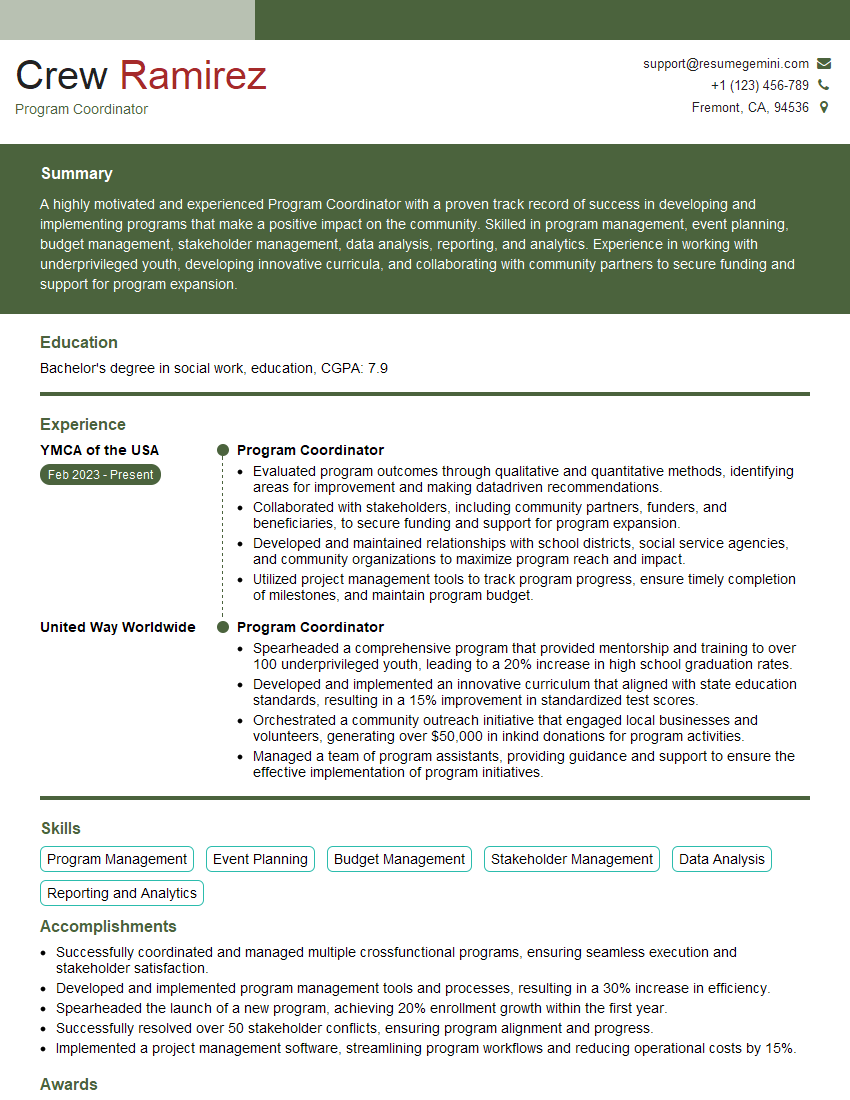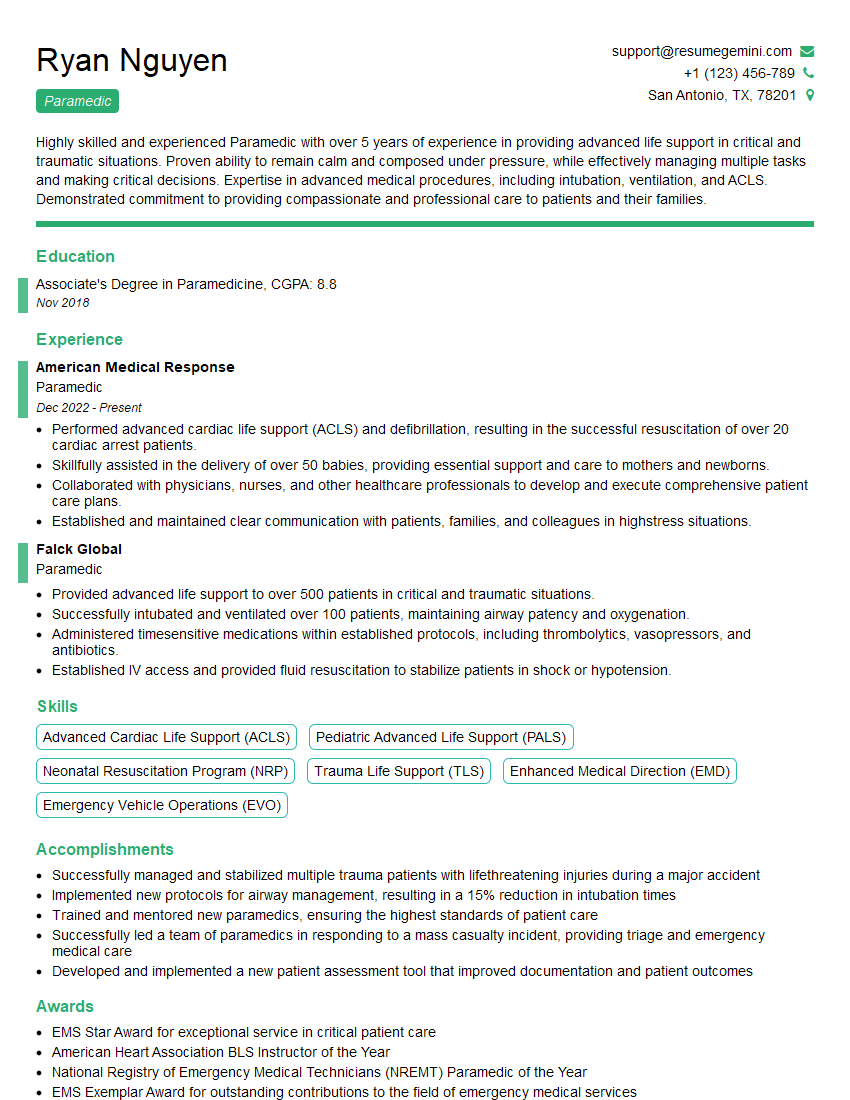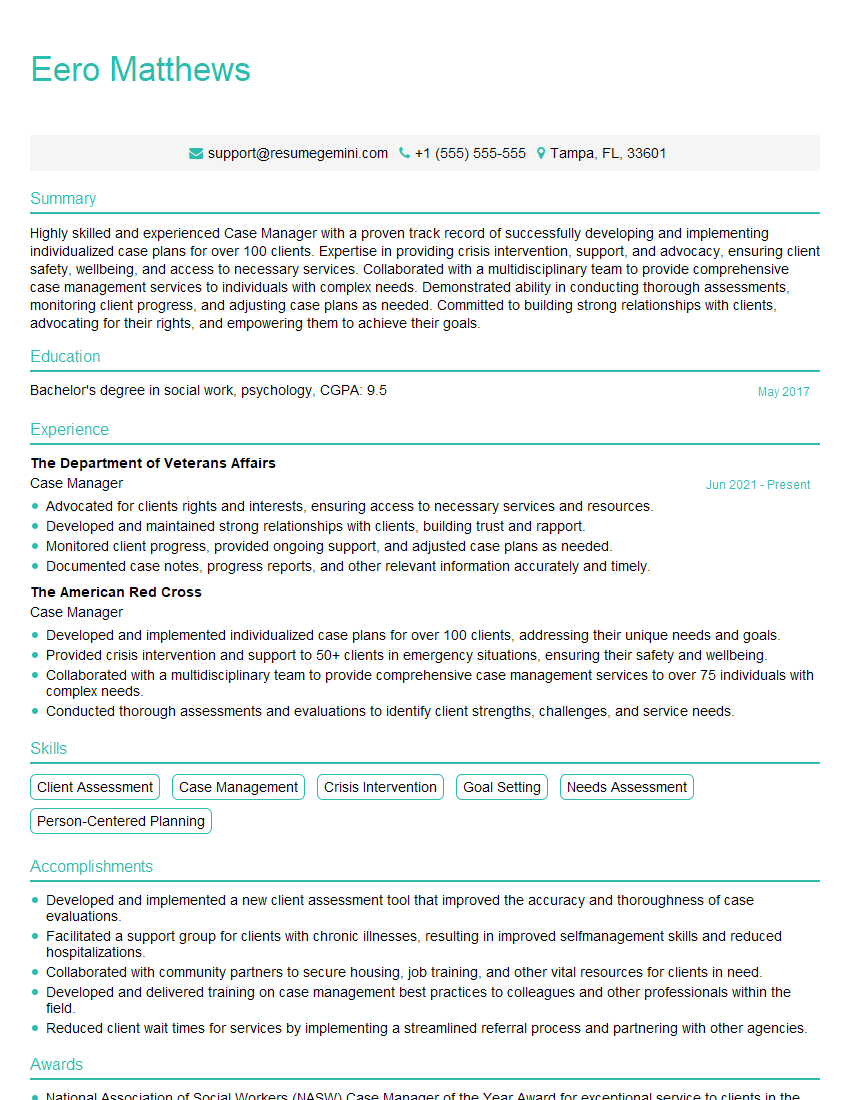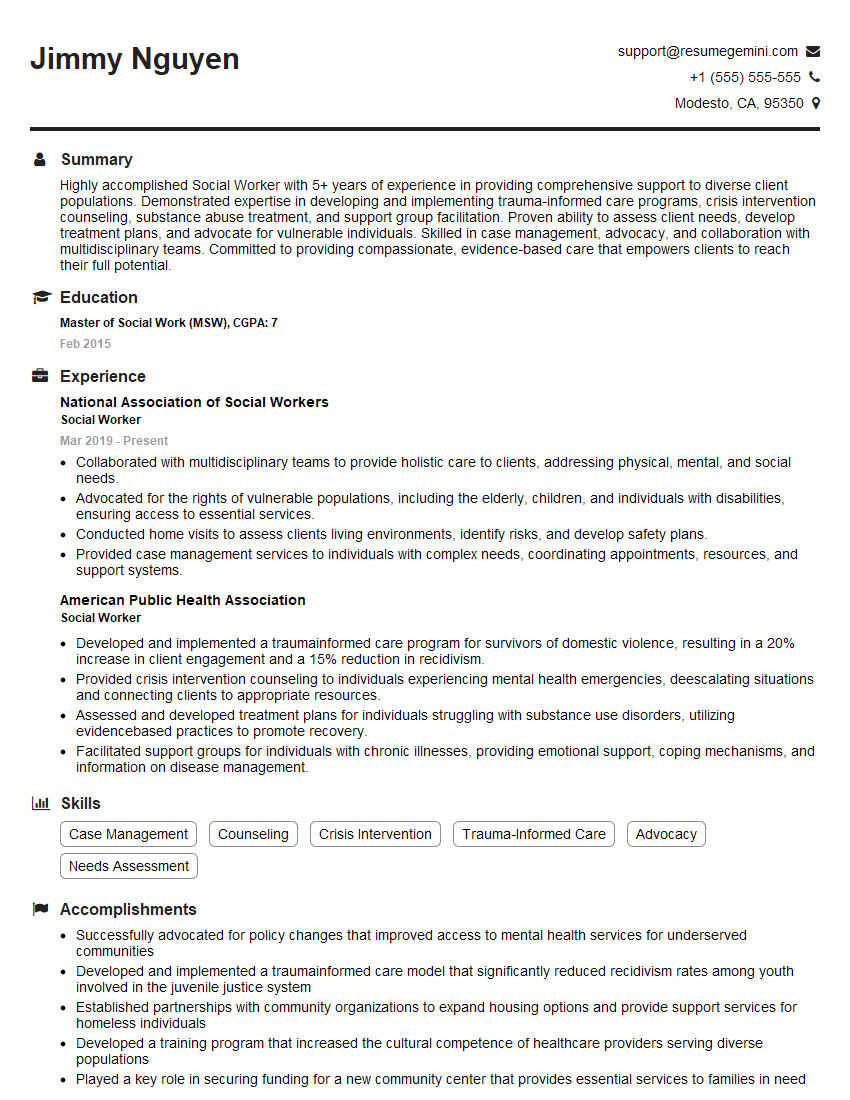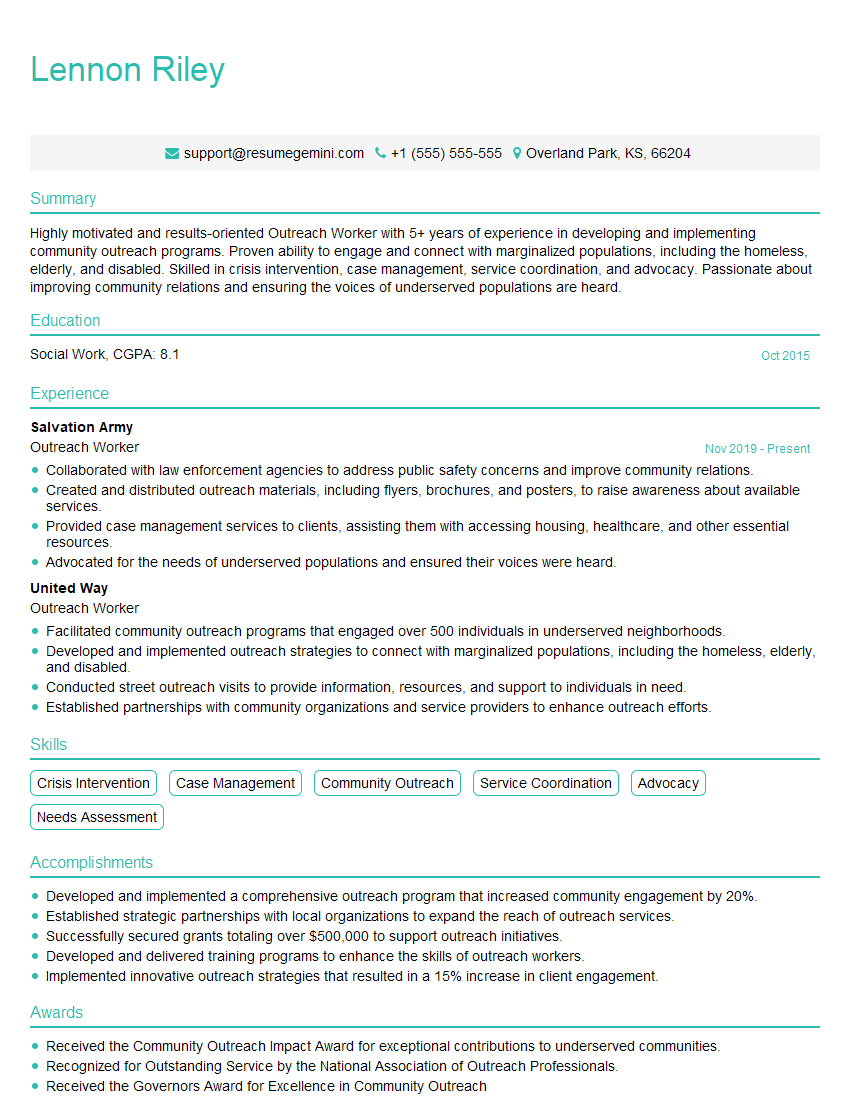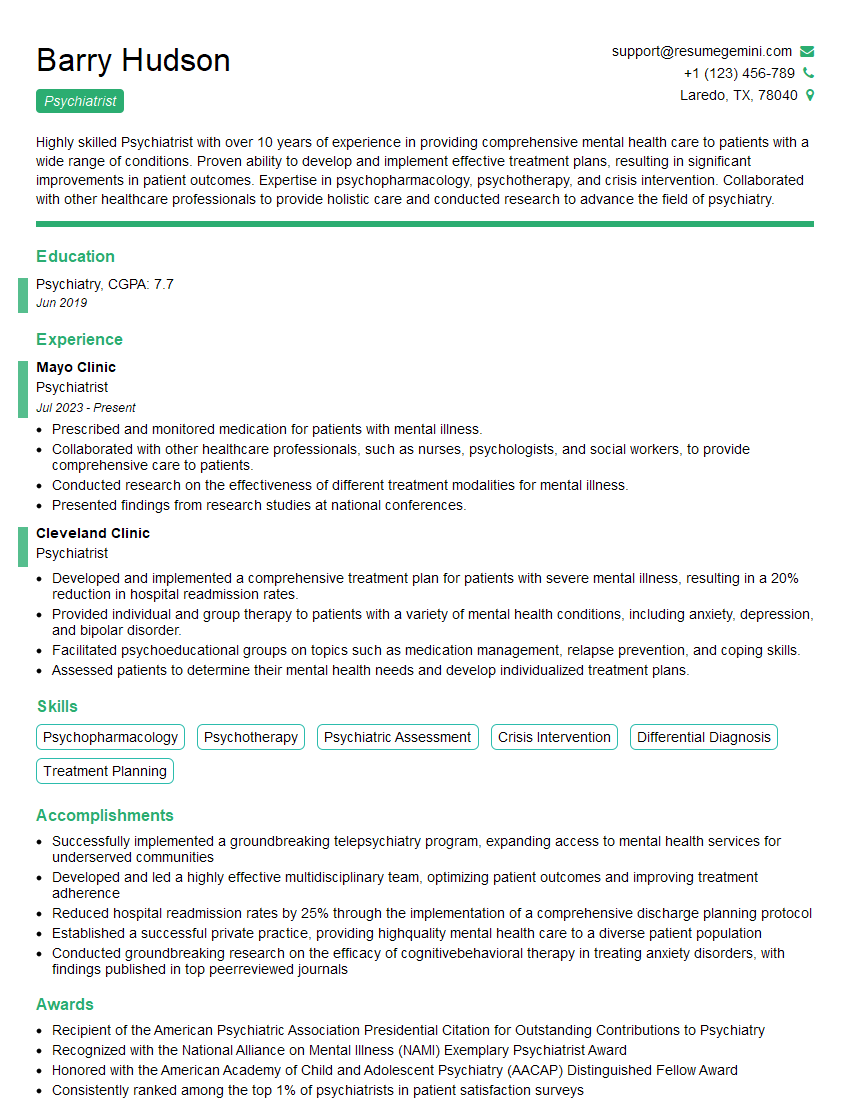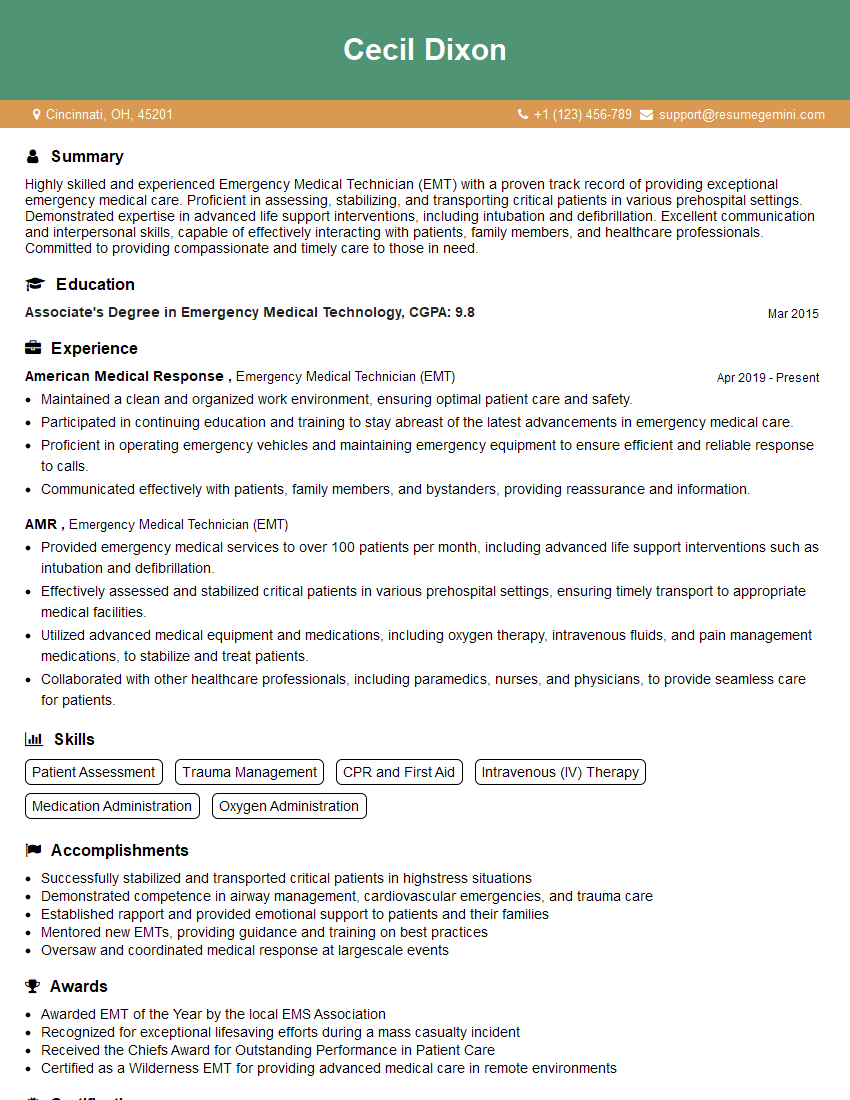Are you ready to stand out in your next interview? Understanding and preparing for Overdose Prevention interview questions is a game-changer. In this blog, we’ve compiled key questions and expert advice to help you showcase your skills with confidence and precision. Let’s get started on your journey to acing the interview.
Questions Asked in Overdose Prevention Interview
Q 1. Describe the physiological effects of opioid overdose.
Opioid overdose occurs when someone takes more opioids than their body can handle, leading to a dangerous suppression of the central nervous system. This suppression affects breathing, heart rate, and consciousness. Think of it like this: opioids are like a dimmer switch for your brain and body. In an overdose, the switch is turned down too far, leading to potentially fatal consequences.
Physiologically, opioids bind to opioid receptors in the brain, slowing down the brain’s signaling. This slows down respiration (breathing) – often to dangerously low levels – leading to hypoxia (lack of oxygen). Heart rate can slow or become irregular. The person may become deeply sedated, unresponsive, and eventually slip into a coma. In severe cases, lack of oxygen can lead to organ damage and death.
Q 2. Explain the mechanism of action of Naloxone.
Naloxone is a medication that reverses opioid overdose by competitively blocking opioid receptors. Imagine it like this: opioids are like keys that fit into a lock (the opioid receptor). Naloxone is another key that fits into the same lock, but it doesn’t turn the lock the same way. Naloxone effectively kicks the opioid off the receptor, restoring some normal brain and body function. This doesn’t remove the opioid from the body, but it rapidly reverses the effects of the opioid by preventing it from binding to receptors.
Specifically, naloxone acts as a competitive antagonist at the mu-opioid receptor, the primary receptor responsible for opioid-induced respiratory depression. By binding to these receptors, it displaces the opioids and reduces their effects on breathing and other functions. The speed of action is crucial in life-threatening situations.
Q 3. What are the signs and symptoms of an opioid overdose?
Recognizing the signs of an opioid overdose is critical. The classic triad of symptoms includes:
- Unresponsiveness: The person is difficult or impossible to rouse.
- Pinpoint pupils: The pupils of the eyes are extremely constricted (very small).
- Slow or absent breathing: Breathing is shallow, slow, or completely stopped.
Other signs can include:
- Blue or gray coloring of the lips and fingertips (cyanosis)
- Gurgling sounds or snoring-like sounds while breathing
- Limp body
- Cold, clammy skin
- Vomiting
It’s crucial to remember that these symptoms don’t always appear together, and the severity can vary. Even one of these signs warrants immediate action.
Q 4. What is the appropriate administration technique for Naloxone?
Naloxone is administered to counteract an opioid overdose. The most common routes are intranasal (through the nose) and intramuscular (into the muscle). Intranasal administration is often preferred for its ease of use and quick absorption. Intramuscular injection is an alternative if intranasal administration isn’t possible or effective.
Intranasal Administration: A pre-measured dose of naloxone is sprayed into one nostril. The person should be positioned lying on their back or side. Ensure the airway is clear. This method is becoming increasingly popular for ease of administration by bystanders.
Intramuscular Injection: This requires training and involves injecting naloxone into a large muscle group like the thigh. This method is usually reserved for trained medical professionals.
After administration, monitor the person’s breathing and level of responsiveness closely. Repeated doses may be necessary, depending on the severity of the overdose and the person’s response. Always call emergency medical services immediately after administering naloxone.
Q 5. What are the limitations of Naloxone?
While naloxone is a lifesaver, it has limitations. It’s not a cure-all; it only temporarily reverses the effects of the opioid. The opioid remains in the system, and withdrawal symptoms can occur in a person who is physically dependent on opioids. The effects of naloxone are short-lived (30-90 minutes), so repeated doses might be necessary. Also, naloxone is ineffective against other types of overdoses (e.g., benzodiazepines). Finally, a rapid reversal of opioid effects can be uncomfortable and cause agitation.
Furthermore, the effectiveness of naloxone is dose-dependent, and the required dosage may vary. It’s crucial to follow the instructions provided by healthcare professionals or on the naloxone packaging precisely.
Q 6. Describe the role of harm reduction in overdose prevention.
Harm reduction strategies focus on minimizing the negative consequences of drug use, rather than solely focusing on abstinence. In the context of overdose prevention, this means providing individuals who use drugs with tools and support to reduce their risk of overdose and its related harms. This approach is based on compassion, respect, and recognizing that individuals with substance use disorders are experts in their own lives.
Harm reduction approaches acknowledge the realities of drug use within society and aim to empower individuals to make safer choices. It’s not about condoning drug use, but about preventing death and disability. A harm reduction approach recognizes that someone struggling with opioid use disorder may not be ready for abstinence, but they can be supported to reduce the risk of an overdose.
Q 7. What are some examples of harm reduction strategies?
Several harm reduction strategies are crucial for overdose prevention:
- Naloxone distribution programs: Making naloxone readily available to individuals who use opioids, their family members, and first responders.
- Good Samaritan laws: Protecting individuals from legal prosecution for seeking or providing assistance during an overdose.
- Supervised consumption sites: Providing a safe, monitored environment where individuals can use drugs under medical supervision.
- Drug checking services: Allowing individuals to test their drugs for potentially harmful contaminants.
- Education and awareness campaigns: Providing accurate information about opioid use, overdose risks, and harm reduction strategies.
- Treatment and support services: Connecting individuals with substance use disorders to evidence-based treatment, including medication-assisted treatment (MAT) such as methadone, buprenorphine, or naltrexone.
Each of these strategies contributes to a multi-faceted approach to reducing overdose deaths and improving the health and well-being of people who use drugs.
Q 8. Explain the concept of Good Samaritan laws related to overdose.
Good Samaritan laws are designed to protect people who provide emergency assistance to someone who is overdosing. Essentially, they limit the legal liability of bystanders who act in good faith to help someone experiencing an overdose, even if their actions aren’t perfectly executed. These laws vary by state and jurisdiction, but generally, they offer protection from civil and sometimes criminal charges, as long as the helper acted reasonably and without malicious intent. For instance, if someone administers Narcan (naloxone) to someone overdosing and makes a minor error in the process that doesn’t worsen the situation, they are generally shielded from legal repercussions. However, these laws don’t offer complete immunity; recklessness or gross negligence might still result in legal consequences.
The key is that these laws are intended to encourage bystanders to intervene in overdose situations without fear of facing legal trouble, ultimately saving lives. They recognize that timely intervention is crucial in overdose cases and aim to remove barriers that might prevent people from assisting.
Q 9. How would you respond to an overdose situation?
Responding to an overdose is a serious matter requiring immediate action. The steps I would take are:
- Assess the situation: Check for responsiveness and breathing. If the person is unconscious and not breathing, immediately call emergency services (911 or your local equivalent).
- Administer naloxone (Narcan): If available and you’re trained to use it, administer naloxone according to the instructions. Naloxone is a medication that can temporarily reverse the effects of an opioid overdose. It’s crucial to remember that it’s not a cure, and even if the person regains consciousness, they still require professional medical attention.
- Initiate CPR: If the person is not breathing or only gasping, begin CPR until emergency medical services arrive.
- Stay with the person: Do not leave the person alone until emergency personnel arrive. Monitor their breathing and level of consciousness. Try to keep them in a recovery position to prevent choking if possible.
- Provide information to EMS: Provide emergency personnel with any relevant information, such as the substance that was potentially taken, the amount, and when it was taken.
It’s imperative to remember that every overdose situation is unique, and adjusting these steps to the specific scenario is vital. Proper training in administering naloxone and CPR is essential for anyone who might encounter such a situation.
Q 10. What are the different types of overdose reversal medications?
The most common overdose reversal medication is naloxone (Narcan), available in various forms such as nasal spray, injection, and auto-injectors. Naloxone is a competitive opioid receptor antagonist, meaning it blocks the effects of opioids at their receptor sites in the brain. This can reverse the respiratory depression caused by opioids, potentially saving a life. Other medications might be used in a hospital setting to manage the consequences of an overdose, but naloxone is the primary and often lifesaving reversal medication for opioid overdoses.
Q 11. What is your understanding of the overdose crisis?
The overdose crisis is a public health emergency characterized by a significant increase in fatal and non-fatal drug overdoses. This crisis is largely driven by the widespread availability and misuse of opioids, such as heroin and fentanyl. The opioid crisis is complex, with contributing factors including the overprescription of opioid painkillers, the rise of illicitly manufactured fentanyl, social and economic inequalities, and mental health issues. The consequences are devastating, leading to countless deaths, broken families, and immense strain on healthcare systems and communities. Addressing this crisis requires a multi-faceted approach encompassing prevention, treatment, harm reduction strategies (such as naloxone distribution and supervised consumption sites), and addressing the underlying social determinants of health that contribute to substance use disorders.
Q 12. What are the risk factors for opioid overdose?
Several risk factors contribute to opioid overdose. These include:
- Using opioids alone: This means there’s no one present to call for help if an overdose occurs.
- Mixing opioids with other drugs or alcohol: This significantly increases the risk of respiratory depression and overdose.
- High potency opioids: Fentanyl is particularly dangerous due to its high potency.
- Tolerance: People with opioid tolerance may unintentionally take a lethal dose.
- Lack of access to treatment: Limited access to addiction treatment and medication-assisted treatment (MAT) can prevent individuals from seeking help.
- Mental health disorders: Co-occurring mental health conditions like depression or anxiety can increase the risk of overdose.
- Lack of awareness about overdose risk: Not understanding the dangers of mixing drugs or the high potency of certain opioids significantly increases the risk.
It’s crucial to remember that these factors often interact, creating a complex web of risk. For instance, someone with an opioid use disorder who is alone, using a high-potency opioid, and is also consuming alcohol is at extremely high risk.
Q 13. What are the protective factors against overdose?
Protective factors against overdose involve strategies and supports that reduce the risk of overdose. Some key protective factors include:
- Access to naloxone: Having naloxone readily available and knowing how to administer it can save lives.
- Medication-assisted treatment (MAT): MAT combines medications like methadone or buprenorphine with counseling and behavioral therapies.
- Access to addiction treatment: Comprehensive addiction treatment programs can help individuals manage their substance use.
- Social support: Strong social networks and supportive relationships can reduce isolation and provide encouragement.
- Harm reduction strategies: Practices like supervised consumption sites minimize risk associated with injection drug use.
- Education and awareness: Understanding the risks of opioid misuse and overdose can empower individuals to make safer choices.
- Stable housing and employment: Addressing social determinants of health like stable housing and employment can significantly decrease the risk of overdose.
The effectiveness of these protective factors often relies on their combined effect and integration into community-level initiatives.
Q 14. How would you educate a community about overdose prevention?
Educating a community about overdose prevention involves a multi-pronged approach that leverages various communication channels and strategies. I would utilize the following approaches:
- Public awareness campaigns: Using various media (posters, social media, local news) to share information about overdose risks, naloxone, and available resources.
- Community workshops and presentations: Conducting interactive sessions to teach about opioid use disorder, overdose prevention, and naloxone administration.
- Training programs for first responders and community members: Providing hands-on training on administering naloxone and performing CPR.
- Partnerships with local organizations: Collaborating with community centers, schools, healthcare providers, and faith-based organizations to broaden outreach.
- Distribution of naloxone: Making naloxone readily accessible through pharmacies, community centers, and harm reduction programs.
- Stigma reduction campaigns: Promoting understanding and empathy towards individuals struggling with opioid use disorder.
- Data-driven approach: Utilizing local overdose data to inform prevention efforts and tailor messages to address specific community needs.
It’s important to utilize language that is accessible, empathetic, and free of judgment. The goal is to empower individuals and communities with knowledge and tools to prevent overdoses and save lives.
Q 15. How would you train individuals on the administration of Naloxone?
Training individuals on Naloxone administration requires a multi-faceted approach focusing on both knowledge and practical skills. We begin with a clear explanation of what an opioid overdose is and how Naloxone works to reverse it. This includes discussing the signs and symptoms of an opioid overdose, emphasizing the importance of recognizing these symptoms quickly. We then move into the practical aspects: how to administer Naloxone via different routes (e.g., intranasal spray, intramuscular injection), how to assess the individual’s response, and what to do after administration, including calling emergency services.
- Hands-on practice: We use realistic training aids and scenarios to allow participants to practice administering Naloxone in a safe environment. This includes practicing on mannequins and role-playing scenarios.
- Emphasis on safety: We thoroughly explain safety precautions, such as proper hand hygiene and disposal of used needles.
- Addressing anxieties: We create a supportive learning environment to address potential anxieties or concerns participants may have about administering Naloxone. This includes providing opportunities for questions and discussion.
- Ongoing support: We provide contact information for ongoing support and resources after the training is complete.
For example, I recently trained a group of community volunteers. One participant, initially hesitant, gained confidence after practicing with the nasal spray and seeing how straightforward the process was. This practical experience reinforced the knowledge she had gained.
Career Expert Tips:
- Ace those interviews! Prepare effectively by reviewing the Top 50 Most Common Interview Questions on ResumeGemini.
- Navigate your job search with confidence! Explore a wide range of Career Tips on ResumeGemini. Learn about common challenges and recommendations to overcome them.
- Craft the perfect resume! Master the Art of Resume Writing with ResumeGemini’s guide. Showcase your unique qualifications and achievements effectively.
- Don’t miss out on holiday savings! Build your dream resume with ResumeGemini’s ATS optimized templates.
Q 16. What are the ethical considerations in overdose prevention?
Ethical considerations in overdose prevention are paramount. They center around autonomy, beneficence, non-maleficence, and justice. Autonomy involves respecting an individual’s right to make their own choices, even if those choices are risky. We must ensure individuals are fully informed and can make decisions without coercion. Beneficence means acting in the best interest of the individual, which in overdose prevention includes providing life-saving interventions. Non-maleficence involves avoiding harm; this means ensuring that the intervention itself doesn’t cause additional harm. Finally, justice requires equitable access to overdose prevention resources, regardless of social status, race, or other factors.
A key ethical dilemma arises when considering mandatory interventions. While saving lives is a primary goal, forced interventions could infringe on individual autonomy. A balance must be struck between preventing harm and upholding individual rights. Another challenge involves the potential for stigma and discrimination. We must ensure that all interactions with individuals who use substances are respectful and non-judgmental. Addressing these ethical complexities demands careful consideration and ongoing reflection.
Q 17. How would you address stigma surrounding substance use disorders?
Addressing the stigma surrounding substance use disorders requires a multi-pronged approach focusing on education, advocacy, and personal narratives. We need to shift the narrative from one of blame and shame to one of compassion and understanding, emphasizing that addiction is a health issue, not a moral failing. This involves educating the public about the biological and social factors that contribute to substance use disorders.
- Public awareness campaigns: We can use powerful storytelling and media campaigns to humanize individuals struggling with addiction.
- Community engagement: Working with community groups and leaders can help foster a more inclusive and supportive environment.
- Promoting person-first language: Using language such as “person with a substance use disorder” rather than “addict” demonstrates respect and empathy.
- Training healthcare professionals: Ensuring healthcare providers receive training on trauma-informed care and understand how to approach conversations about substance use without judgment is crucial.
For instance, sharing personal stories of recovery can have a profound impact, helping to break down stereotypes and build empathy. By normalizing conversations around addiction, we can encourage individuals to seek help without fear of judgment.
Q 18. What data sources would you utilize to track overdose trends?
Tracking overdose trends requires utilizing multiple data sources to obtain a comprehensive picture. This includes:
- Mortality data: Death certificates provide valuable information on the cause and circumstances of fatal overdoses, including the substances involved. This data is typically collected by vital statistics offices and public health agencies.
- Emergency medical services (EMS) data: EMS records contain information on non-fatal overdoses, allowing for an understanding of trends in the community. This data can be analyzed for patterns in geographic locations, times of day, and substances involved.
- Hospital discharge data: Hospital records capture cases of overdose treated in hospital settings, complementing EMS data.
- Surveillance data from substance use treatment facilities: Data from treatment centers can provide insights into substance use patterns and associated risk factors.
- Syndromic surveillance systems: These systems collect data from various sources (e.g., emergency departments, poison control centers) to identify potential outbreaks of overdoses and other health issues.
Data from these various sources can be combined and analyzed to reveal crucial trends, enabling targeted interventions.
Q 19. How do you evaluate the effectiveness of an overdose prevention program?
Evaluating the effectiveness of an overdose prevention program requires a multi-faceted approach combining quantitative and qualitative methods. We need to measure changes in key indicators:
- Reduction in overdose deaths: This is the primary outcome measure. We compare overdose mortality rates before and after program implementation.
- Changes in overdose hospitalizations: This data helps understand the impact of programs on non-fatal overdoses.
- Naloxone distribution and administration rates: This indicator tracks program reach and impact. We can also assess how many lives were potentially saved due to Naloxone administration.
- Changes in knowledge, attitudes, and behaviors: This involves surveys and focus groups to understand program impact on knowledge of overdose prevention, attitudes toward substance use disorders, and behaviors related to safer substance use.
- Program reach and coverage: This assesses how well the program is reaching target populations and whether it is equitably distributed across different communities.
By combining quantitative data (e.g., mortality rates, Naloxone distribution) with qualitative data (e.g., community feedback, participant experiences), we gain a more holistic understanding of program effectiveness.
Q 20. What are some challenges in implementing overdose prevention initiatives?
Implementing overdose prevention initiatives faces several challenges. These include:
- Funding limitations: Securing adequate funding for comprehensive programs is often a significant hurdle.
- Political and social barriers: Resistance to harm reduction strategies can stem from misconceptions and stigmatizing attitudes towards substance use.
- Accessibility of resources: Ensuring equitable access to naloxone, treatment, and other resources across diverse communities, particularly those with limited resources, can be challenging.
- Data limitations: Insufficient data collection or data quality can hamper evaluation efforts and hinder the ability to adapt and improve programs.
- Collaboration challenges: Effective overdose prevention requires strong collaborations across various sectors (healthcare, law enforcement, community organizations). Coordinating these efforts can be complex.
- Stigma and discrimination: Addressing societal stigma and ensuring non-judgmental interactions with individuals struggling with substance use is essential but often difficult to achieve.
Overcoming these challenges requires a multi-pronged approach involving strong advocacy, effective community engagement, and a commitment to evidence-based interventions.
Q 21. Describe your experience with community outreach programs.
My experience with community outreach programs has been extensive. I’ve been involved in developing and implementing numerous programs designed to reach vulnerable populations. These programs have involved collaborative efforts with local agencies, community centers, and harm reduction organizations. We’ve employed various strategies, including:
- Community events and workshops: We conduct workshops on overdose prevention, naloxone administration, and other harm reduction strategies at community centers, schools, and other public spaces.
- Direct outreach to high-risk populations: We work directly with individuals who use substances in various settings, such as shelters and encampments, to provide naloxone and other support services. This often involves building trust and rapport, which takes time and sensitivity.
- Peer-to-peer education: We’ve trained individuals with lived experience of addiction to act as peer educators, as they can often connect more effectively with others.
- Distribution of naloxone: We’ve developed systems to distribute naloxone easily and safely to those at risk, such as through take-home programs and partnerships with pharmacies.
One particularly successful initiative involved partnering with a local needle exchange program to integrate naloxone distribution. This strategy resulted in a significant increase in naloxone distribution to high-risk individuals.
Q 22. How do you build rapport with individuals who use substances?
Building rapport with individuals who use substances is crucial for effective overdose prevention. It’s about establishing trust and demonstrating genuine care, not judgment. Think of it like building any other relationship – it takes time, patience, and respect.
I start by introducing myself, clearly stating my role, and emphasizing that I’m there to help without judgment. I use active listening, reflecting back what they’re saying to show I understand. I avoid using confrontational language or making assumptions. For example, instead of saying ‘You need to stop using drugs,’ I might say, ‘I’m concerned about your safety and want to explore what support might help you.’ Nonverbal communication is key – maintaining appropriate eye contact, using open body language, and showing empathy are essential.
I also strive to understand their individual circumstances and perspectives. What challenges are they facing? What are their goals? By acknowledging their experiences and validating their feelings, I create a safe space where they feel comfortable opening up. This can involve sharing relevant personal experiences (if appropriate), while always respecting boundaries. Remember, building rapport is an ongoing process; it’s not a one-time event.
Q 23. What is your understanding of the social determinants of health and their impact on overdose?
Social determinants of health (SDOH) are the conditions in the environments where people are born, live, learn, work, play, worship, and age that affect a wide range of health, functioning, and quality-of-life outcomes and risks. These factors significantly impact the risk of overdose. Poverty, lack of access to healthcare, unstable housing, food insecurity, discrimination, and trauma all increase vulnerability to substance use and overdose.
For example, someone experiencing homelessness might resort to substance use as a coping mechanism for the stress and trauma of their situation. They might lack access to treatment or naloxone (an overdose reversal medication) due to limited resources. Similarly, someone facing systemic racism might experience disproportionate stress, leading to substance use, and lack access to culturally competent care.
Understanding SDOH is critical for effective overdose prevention strategies. We need to address the root causes of substance use, not just the symptoms. This requires a collaborative approach involving healthcare professionals, social workers, housing providers, and community organizations to create supportive environments that promote well-being and reduce disparities in access to resources.
Q 24. How would you handle a situation where an individual refuses help for an overdose?
If an individual refuses help for an overdose, my priority shifts to ensuring their safety and providing information. I can’t force someone to accept help, but I can continue to offer support and resources in a non-coercive way. I would reiterate my concern, explain the risks of overdose in clear and simple terms, and offer a range of options. This could include providing information on harm reduction strategies, connecting them with peer support, or offering to contact a crisis line or medical professional on their behalf.
Documenting the refusal, along with the reason provided (if any), and any steps taken is crucial. This information can be valuable for future interactions. It’s important to respect their autonomy while also advocating for their safety. I’d maintain contact, if appropriate and they are willing, to offer assistance later when they may be more receptive. Persistent but respectful follow-up can make a difference. However, respecting their decision at this time is paramount.
Q 25. How do you prioritize safety in an overdose intervention?
Prioritizing safety during an overdose intervention is paramount. The first step is to assess the scene for any immediate dangers – is it safe to approach the individual? Are there any other individuals present who may pose a risk? Once safety is ensured, I would call emergency services (911 or local equivalent) immediately.
While waiting for emergency responders, I would check the individual’s responsiveness and breathing. If they’re not breathing or their breathing is shallow and labored, I would administer naloxone if trained and available. I would follow all the instructions provided with the naloxone kit. After administering naloxone, I would continue to monitor their breathing and responsiveness until emergency services arrive. If there’s a risk of airway obstruction, I’d place the individual in the recovery position. Throughout this, the priority is maintaining a calm demeanor and providing reassurance.
Q 26. What resources would you refer someone to after an overdose event?
After an overdose event, referring the individual to appropriate resources is crucial for preventing future overdoses. This depends on the individual’s needs and preferences. Common referrals might include:
- Substance use treatment programs: These programs offer various levels of care, from detoxification to long-term residential treatment.
- Medication-assisted treatment (MAT): MAT combines medication with behavioral therapies to treat opioid addiction.
- Mental health services: Addressing underlying mental health conditions is crucial, as many individuals with substance use disorders also experience mental health issues.
- Peer support groups: Connecting with others who have faced similar challenges can provide valuable support and reduce feelings of isolation.
- Harm reduction programs: These programs focus on minimizing the negative consequences of substance use, such as needle exchange programs and naloxone distribution.
- Housing and social services: Addressing social determinants of health is crucial, ensuring access to stable housing, food security, and other essential resources.
It’s important to ensure the individual understands the purpose of each referral and feels comfortable accessing the services. Providing clear and concise information, along with contact details, and potentially accompanying them to their first appointment can be highly beneficial.
Q 27. How would you adapt your approach to individuals with different cultural backgrounds?
Adapting my approach to individuals with different cultural backgrounds requires cultural humility and sensitivity. This means acknowledging my own biases, recognizing that cultural norms and beliefs vary greatly, and actively seeking to understand the individual’s unique perspective. Simply put, I need to be respectful and learn from the individual, not impose my own worldview.
I would start by asking about their cultural background and preferences for communication. Some cultures may value direct communication, while others may prefer a more indirect or indirect approach. I would make every effort to find a translator or interpreter if there is a language barrier. I would also be mindful of any cultural beliefs or practices that may influence their understanding of substance use or treatment. For example, in some cultures, seeking professional mental health support may carry a stigma.
Collaborating with community leaders and culturally competent organizations can help me gain a better understanding of the cultural context and ensure culturally appropriate services are provided. Involving family members or trusted community members in the treatment plan (if the individual consents) can also enhance engagement and success.
Q 28. Describe your knowledge of relevant legislation concerning overdose prevention.
My knowledge of relevant legislation concerning overdose prevention is crucial to my work. Legislation varies by jurisdiction, but generally, there are laws that address various aspects of overdose prevention, including:
- Good Samaritan laws: These laws protect individuals from legal repercussions when they call for emergency medical assistance for someone experiencing an overdose. The specific details of these laws vary greatly.
- Naloxone access laws: Many jurisdictions have laws that make naloxone more accessible to the public, including allowing for its purchase without a prescription and providing training on its administration.
- Controlled Substances Act (CSA): The CSA and similar legislation govern the prescribing, dispensing, and possession of controlled substances. Understanding this legislation is essential for those working in substance use treatment.
- Laws related to harm reduction strategies: There are laws and regulations around harm reduction initiatives like supervised consumption sites or needle exchange programs. The legality and regulations of such programs can greatly differ by location.
Staying updated on the relevant legislation in my area is critical to ensure that my actions comply with the law and I can effectively advocate for policies that support overdose prevention.
Key Topics to Learn for Overdose Prevention Interview
- Understanding Opioid Use Disorder: Theoretical frameworks surrounding addiction, including the biological, psychological, and social factors contributing to opioid dependence. Practical application: Assessing individual needs and tailoring intervention strategies.
- Harm Reduction Strategies: Exploring the philosophy and practical implementation of harm reduction, including naloxone administration, safe injection sites, and needle exchange programs. Practical application: Developing and implementing harm reduction initiatives within a community setting.
- Overdose Recognition and Response: Mastering the identification of overdose symptoms, effective response techniques (e.g., administering naloxone, CPR), and post-overdose care. Practical application: Simulating real-life scenarios and practicing effective response protocols.
- Community Engagement and Outreach: Understanding strategies for reaching vulnerable populations, building trust, and effectively educating communities about overdose prevention. Practical application: Designing and implementing public health campaigns targeting high-risk individuals and communities.
- Data Collection and Analysis: Learning how to collect, analyze, and interpret data related to overdose trends, risk factors, and the effectiveness of interventions. Practical application: Utilizing data to inform program development and resource allocation.
- Ethical Considerations and Legal Frameworks: Understanding the ethical implications of overdose prevention strategies and navigating relevant legal frameworks. Practical application: Developing ethical guidelines for working with individuals struggling with addiction.
- Collaboration and Teamwork: Understanding the importance of interdisciplinary collaboration with healthcare providers, social workers, law enforcement, and community organizations. Practical application: Developing and implementing effective collaborative strategies for overdose prevention.
Next Steps
Mastering Overdose Prevention demonstrates a crucial commitment to public health and significantly enhances your career prospects in social work, public health, nursing, and related fields. To maximize your chances of securing your dream role, a strong and ATS-friendly resume is essential. ResumeGemini is a trusted resource that can help you craft a compelling resume that highlights your skills and experience effectively. They offer examples of resumes tailored specifically to Overdose Prevention roles, helping you showcase your expertise and qualifications to potential employers. Invest time in creating a professional resume to increase your interview success rate.
Explore more articles
Users Rating of Our Blogs
Share Your Experience
We value your feedback! Please rate our content and share your thoughts (optional).
What Readers Say About Our Blog
Interesting Article, I liked the depth of knowledge you’ve shared.
Helpful, thanks for sharing.
Hi, I represent a social media marketing agency and liked your blog
Hi, I represent an SEO company that specialises in getting you AI citations and higher rankings on Google. I’d like to offer you a 100% free SEO audit for your website. Would you be interested?
